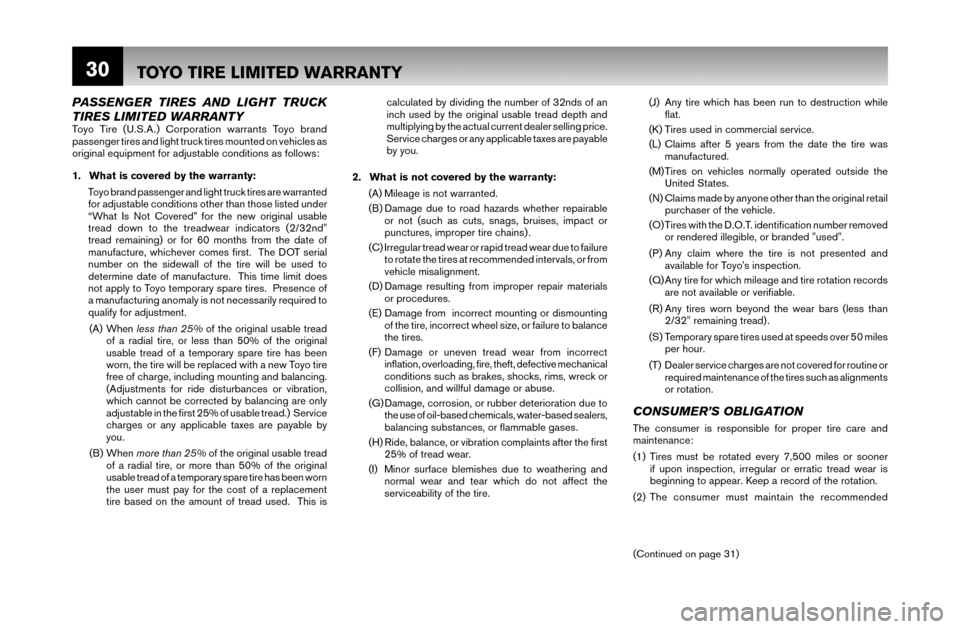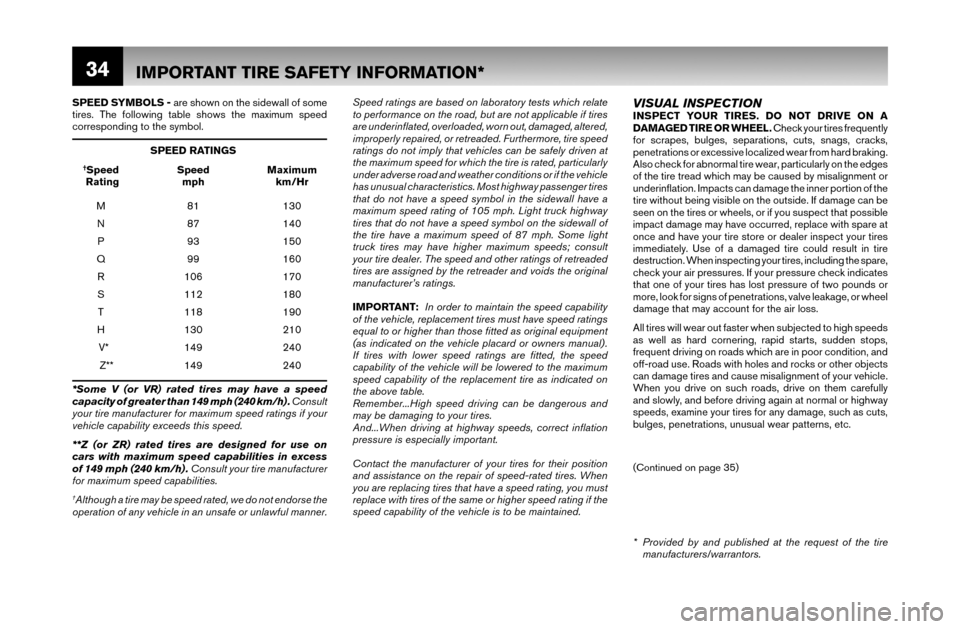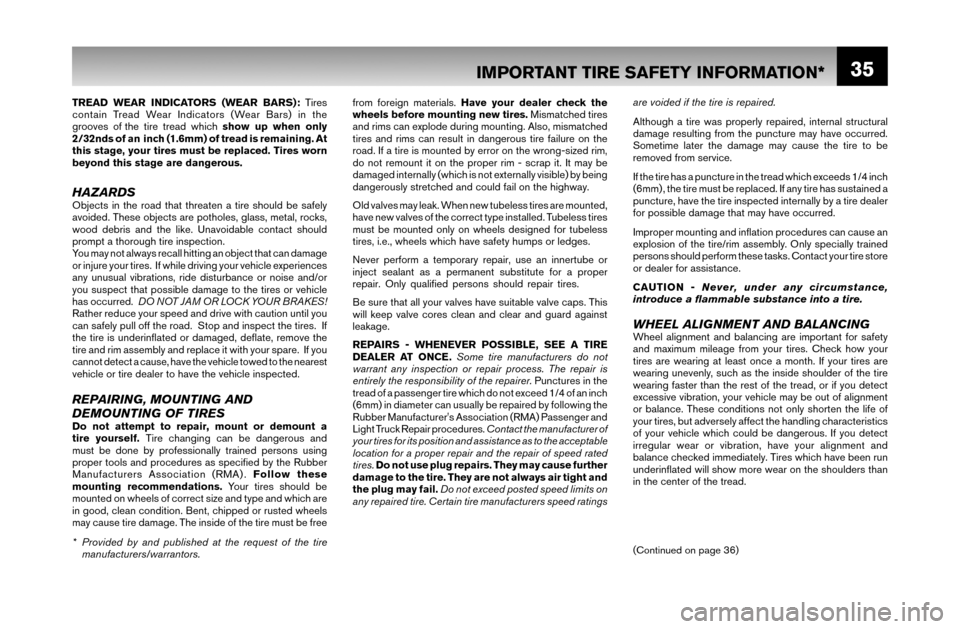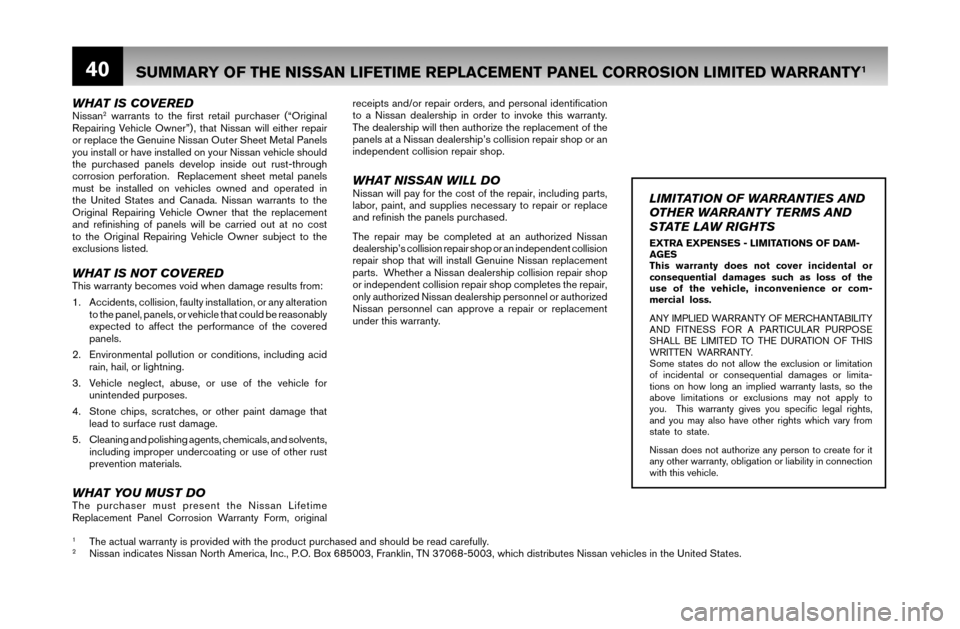light NISSAN FRONTIER 2007 D22 / 1.G Warranty Booklet
[x] Cancel search | Manufacturer: NISSAN, Model Year: 2007, Model line: FRONTIER, Model: NISSAN FRONTIER 2007 D22 / 1.GPages: 55, PDF Size: 5.93 MB
Page 33 of 55

30
PASSENGER TIRES AND LIGHT TRUCK
TIRES LIMITED WARRANTY
Toyo Tire (U.S.A.) Corporation warrants Toyo brand
passenger tires and light truck tires mounted on vehicles as
original equipment for adjustable conditions as follows:
1. What is covered by the warranty:
Toyo brand passenger and light truck tires are warranted
for adjustable conditions other than those listed under
“What Is Not Covered” for the new original usable
tread down to the treadwear indicators (2/32nd"
tread remaining) or for 60 months from the date of
manufacture, whichever comes fi rst. The DOT serial
number on the sidewall of the tire will be used to
determine date of manufacture. This time limit does
not apply to Toyo temporary spare tires. Presence of
a manufacturing anomaly is not necessarily required to
qualify for adjustment.
(A) When less than 25% of the original usable tread
of a radial tire, or less than 50% of the original
usable tread of a temporary spare tire has been
worn, the tire will be replaced with a new Toyo tire
free of charge, including mounting and balancing.
(Adjustments for ride disturbances or vibration,
which cannot be corrected by balancing are only
adjustable in the fi rst 25% of usable tread.) Service
charges or any applicable taxes are payable by
you.
(B) When more than 25% of the original usable tread
of a radial tire, or more than 50% of the original
usable tread of a temporary spare tire has been worn
the user must pay for the cost of a replacement
tire based on the amount of tread used. This is calculated by dividing the number of 32nds of an
inch used by the original usable tread depth and
multiplying by the actual current dealer selling price.
Service charges or any applicable taxes are payable
by you.
2. What is not covered by the warranty:
(A) Mileage is not warranted.
(B) Damage due to road hazards whether repairable
or not (such as cuts, snags, bruises, impact or
punctures, improper tire chains) .
(C) Irregular tread wear or rapid tread wear due to failure
to rotate the tires at recommended intervals, or from
vehicle misalignment.
(D) Damage resulting from improper repair materials
or procedures.
(E) Damage from incorrect mounting or dismounting
of the tire, incorrect wheel size, or failure to balance
the tires.
(F) Damage or uneven tread wear from incorrect
infl ation, overloading, fi re, theft, defective mechanical
conditions such as brakes, shocks, rims, wreck or
collision, and willful damage or abuse.
(G) Damage, corrosion, or rubber deterioration due to
the use of oil-based chemicals, water-based sealers,
balancing substances, or fl ammable gases.
(H) Ride, balance, or vibration complaints after the fi rst
25% of tread wear.
(I) Minor surface blemishes due to weathering and
normal wear and tear which do not affect the
serviceability of the tire.(J) Any tire which has been run to destruction while
fl a t .
(K) Tires used in commercial service.
(L) Claims after 5 years from the date the tire was
manufactured.
(M) Tires on vehicles normally operated outside the
United States.
(N) Claims made by anyone other than the original retail
purchaser of the vehicle.
(O) Tires with the D.O.T. identifi cation number removed
or rendered illegible, or branded "used".
(P) Any claim where the tire is not presented and
available for Toyo's inspection.
(Q) Any tire for which mileage and tire rotation records
are not available or verifi able.
(R) Any tires worn beyond the wear bars (less than
2/32" remaining tread) .
(S) Temporary spare tires used at speeds over 50 miles
per hour.
(T) Dealer service charges are not covered for routine or
required maintenance of the tires such as alignments
or rotation.
CONSUMER’S OBLIGATION
The consumer is responsible for proper tire care and
maintenance:
(1) Tires must be rotated every 7,500 miles or sooner
if upon inspection, irregular or erratic tread wear is
beginning to appear. Keep a record of the rotation.
(2) The consumer must maintain the recommended
TOYO TIRE LIMITED WARRANTY
(Continued on page 31)
57052 Booklet text pages.indd 3057052 Booklet text pages.indd 308/30/06 3:34:24 PM8/30/06 3:34:24 PM
Page 37 of 55

34
SPEED SYMBOLS - are shown on the sidewall of some
tires. The following table shows the maximum speed
corresponding to the symbol.
SPEED RATINGS
†Speed Speed Maximum
Rating mph km/Hr
M 81 130
N 87 140
P 93 150
Q 99 160
R 106 170
S 112 180
T 118 190
H 130 210
V* 149 240
Z** 149 240
*Some V (or VR) rated tires may have a speed
capacity of greater than 149 mph (240 km/h) . Consult
your tire manufacturer for maximum speed ratings if your
vehicle capability exceeds this speed.
**Z (or ZR) rated tires are designed for use on
cars with maximum speed capabilities in excess
of 149 mph (240 km/h) . Consult your tire manufacturer
for maximum speed capabilities.
†Although a tire may be speed rated, we do not endorse the
operation of any vehicle in an unsafe or unlawful manner. Speed ratings are based on laboratory tests which relate
to performance on the road, but are not applicable if tires
are underinfl ated, overloaded, worn out, damaged, altered,
improperly repaired, or retreaded. Furthermore, tire speed
ratings do not imply that vehicles can be safely driven at
the maximum speed for which the tire is rated, particularly
under adverse road and weather conditions or if the vehicle
has unusual characteristics. Most highway passenger tires
that do not have a speed symbol in the sidewall have a
maximum speed rating of 105 mph. Light truck highway
tires that do not have a speed symbol on the sidewall of
the tire have a maximum speed of 87 mph. Some light
truck tires may have higher maximum speeds; consult
your tire dealer. The speed and other ratings of retreaded
tires are assigned by the retreader and voids the original
manufacturer’s ratings.
IMPORTANT: In order to maintain the speed capability
of the vehicle, replacement tires must have speed ratings
equal to or higher than those fi tted as original equipment
(as indicated on the vehicle placard or owners manual) .
If tires with lower speed ratings are fi tted, the speed
capability of the vehicle will be lowered to the maximum
speed capability of the replacement tire as indicated on
the above table.
Remember...High speed driving can be dangerous and
may be damaging to your tires.
And...When driving at highway speeds, correct infl ation
pressure is especially important.
Contact the manufacturer of your tires for their position
and assistance on the repair of speed-rated tires. When
you are replacing tires that have a speed rating, you must
replace with tires of the same or higher speed rating if the
speed capability of the vehicle is to be maintained.
VISUAL INSPECTIONINSPECT YOUR TIRES. DO NOT DRIVE ON A
DAMAGED TIRE OR WHEEL. Check your tires frequently
for scrapes, bulges, separations, cuts, snags, cracks,
penetrations or excessive localized wear from hard braking.
Also check for abnormal tire wear, particularly on the edges
of the tire tread which may be caused by misalignment or
underinfl ation. Impacts can damage the inner portion of the
tire without being visible on the outside. If damage can be
seen on the tires or wheels, or if you suspect that possible
impact damage may have occurred, replace with spare at
once and have your tire store or dealer inspect your tires
immediately. Use of a damaged tire could result in tire
destruction. When inspecting your tires, including the spare,
check your air pressures. If your pressure check indicates
that one of your tires has lost pressure of two pounds or
more, look for signs of penetrations, valve leakage, or wheel
damage that may account for the air loss.
All tires will wear out faster when subjected to high speeds
as well as hard cornering, rapid starts, sudden stops,
frequent driving on roads which are in poor condition, and
off-road use. Roads with holes and rocks or other objects
can damage tires and cause misalignment of your vehicle.
When you drive on such roads, drive on them carefully
and slowly, and before driving again at normal or highway
speeds, examine your tires for any damage, such as cuts,
bulges, penetrations, unusual wear patterns, etc.
* Provided by and published at the request of the tire
manufacturers/warrantors.
IMPORTANT TIRE SAFETY INFORMATION*
(Continued on page 35)
57052 Booklet text pages.indd 3457052 Booklet text pages.indd 348/30/06 3:34:27 PM8/30/06 3:34:27 PM
Page 38 of 55

35
TREAD WEAR INDICATORS (WEAR BARS): Tires
contain Tread Wear Indicators (Wear Bars) in the
grooves of the tire tread which show up when only
2/32nds of an inch (1.6mm) of tread is remaining. At
this stage, your tires must be replaced. Tires worn
beyond this stage are dangerous.
HAZARDSObjects in the road that threaten a tire should be safely
avoided. These objects are potholes, glass, metal, rocks,
wood debris and the like. Unavoidable contact should
prompt a thorough tire inspection.
You may not always recall hitting an object that can damage
or injure your tires. If while driving your vehicle experiences
any unusual vibrations, ride disturbance or noise and/or
you suspect that possible damage to the tires or vehicle
has occurred. DO NOT JAM OR LOCK YOUR BRAKES!
Rather reduce your speed and drive with caution until you
can safely pull off the road. Stop and inspect the tires. If
the tire is underinfl ated or damaged, defl ate, remove the
tire and rim assembly and replace it with your spare. If you
cannot detect a cause, have the vehicle towed to the nearest
vehicle or tire dealer to have the vehicle inspected.
REPAIRING, MOUNTING AND
DEMOUNTING OF TIRES
Do not attempt to repair, mount or demount a
tire yourself. Tire changing can be dangerous and
must be done by professionally trained persons using
proper tools and procedures as specifi ed by the Rubber
Manufacturers Association (RMA) . Follow these
mounting recommendations. Your tires should be
mounted on wheels of correct size and type and which are
in good, clean condition. Bent, chipped or rusted wheels
may cause tire damage. The inside of the tire must be free from foreign materials. Have your dealer check the
wheels before mounting new tires. Mismatched tires
and rims can explode during mounting. Also, mismatched
tires and rims can result in dangerous tire failure on the
road. If a tire is mounted by error on the wrong-sized rim,
do not remount it on the proper rim - scrap it. It may be
damaged internally (which is not externally visible) by being
dangerously stretched and could fail on the highway.
Old valves may leak. When new tubeless tires are mounted,
have new valves of the correct type installed. Tubeless tires
must be mounted only on wheels designed for tubeless
tires, i.e., wheels which have safety humps or ledges.
Never perform a temporary repair, use an innertube or
inject sealant as a permanent substitute for a proper
repair. Only qualifi ed persons should repair tires.
Be sure that all your valves have suitable valve caps. This
will keep valve cores clean and clear and guard against
leakage.
REPAIRS - WHENEVER POSSIBLE, SEE A TIRE
DEALER AT ONCE. Some tire manufacturers do not
warrant any inspection or repair process. The repair is
entirely the responsibility of the repairer. Punctures in the
tread of a passenger tire which do not exceed 1/4 of an inch
(6mm) in diameter can usually be repaired by following the
Rubber Manufacturer's Association (RMA) Passenger and
Light Truck Repair procedures. Contact the manufacturer of
your tires for its position and assistance as to the acceptable
location for a proper repair and the repair of speed rated
tires. Do not use plug repairs. They may cause further
damage to the tire. They are not always air tight and
the plug may fail. Do not exceed posted speed limits on
any repaired tire. Certain tire manufacturers speed ratings are voided if the tire is repaired.
Although a tire was properly repaired, internal structural
damage resulting from the puncture may have occurred.
Sometime later the damage may cause the tire to be
removed from service.
If the tire has a puncture in the tread which exceeds 1/4 inch
(6mm) , the tire must be replaced. If any tire has sustained a
puncture, have the tire inspected internally by a tire dealer
for possible damage that may have occurred.
Improper mounting and infl ation procedures can cause an
explosion of the tire/rim assembly. Only specially trained
persons should perform these tasks. Contact your tire store
or dealer for assistance.
CAUTION - Never, under any circumstance,
introduce a fl ammable substance into a tire.
WHEEL ALIGNMENT AND BALANCINGWheel alignment and balancing are important for safety
and maximum mileage from your tires. Check how your
tires are wearing at least once a month. If your tires are
wearing unevenly, such as the inside shoulder of the tire
wearing faster than the rest of the tread, or if you detect
excessive vibration, your vehicle may be out of alignment
or balance. These conditions not only shorten the life of
your tires, but adversely affect the handling characteristics
of your vehicle which could be dangerous. If you detect
irregular wear or vibration, have your alignment and
balance checked immediately. Tires which have been run
underinfl ated will show more wear on the shoulders than
in the center of the tread.
* Provided by and published at the request of the tire
manufacturers/warrantors.
IMPORTANT TIRE SAFETY INFORMATION*
(Continued on page 36)
57052 Booklet text pages.indd 3557052 Booklet text pages.indd 358/30/06 3:34:27 PM8/30/06 3:34:27 PM
Page 43 of 55

40
L
w
t
v
a
a
C
W
a
s
t
a
s
d
t
f
w
w
*
T
i
WHAT IS COVEREDNissan2 warrants to the fi rst retail purchaser (“Original
Repairing Vehicle Owner”) , that Nissan will either repair
or replace the Genuine Nissan Outer Sheet Metal Panels
you install or have installed on your Nissan vehicle should
the purchased panels develop inside out rust-through
corrosion perforation. Replacement sheet metal panels
must be installed on vehicles owned and operated in
the United States and Canada. Nissan warrants to the
Original Repairing Vehicle Owner that the replacement
and refi nishing of panels will be carried out at no cost
to the Original Repairing Vehicle Owner subject to the
exclusions listed.
WHAT IS NOT COVEREDThis warranty becomes void when damage results from:
1. Accidents, collision, faulty installation, or any alteration
to the panel, panels, or vehicle that could be reasonably
expected to affect the performance of the covered
panels.
2. Environmental pollution or conditions, including acid
rain, hail, or lightning.
3. Vehicle neglect, abuse, or use of the vehicle for
unintended purposes.
4. Stone chips, scratches, or other paint damage that
lead to surface rust damage.
5. Cleaning and polishing agents, chemicals, and solvents,
including improper undercoating or use of other rust
prevention materials.
WHAT YOU MUST DOThe purchaser must present the Nissan Lifetime
Replacement Panel Corrosion Warranty Form, original
1 The actual warranty is provided with the product purchased and should be read carefully.2 Nissan indicates Nissan North America, Inc., P.O. Box 685003, Franklin, TN 37068-5003, which distributes Nissan vehicles in the United States.
SUMMARY OF THE NISSAN LIFETIME REPLACEMENT PANEL CORROSION LIMITED WARRANTY1
LIMITATION OF WARRANTIES AND
OTHER WARRANTY TERMS AND
STATE LAW RIGHTS
EXTRA EXPENSES - LIMITATIONS OF DAM-
AGES
This warranty does not cover incidental or
consequential damages such as loss of the
use of the vehicle, inconvenience or com-
mercial loss.
ANY IMPLIED WARRANTY OF MERCHANTABILITY
AND FITNESS FOR A PARTICULAR PURPOSE
SHALL BE LIMITED TO THE DURATION OF THIS
WRITTEN WARRANTY.
Some states do not allow the exclusion or limitation
of incidental or consequential damages or limita-
tions on how long an implied warranty lasts, so the
above limitations or exclusions may not apply to
you. This warranty gives you specifi c legal rights,
and you may also have other rights which vary from
state to state.
Nissan does not authorize any person to create for it
any other warranty, obligation or liability in connection
with this vehicle.
receipts and/or repair orders, and personal identifi cation
to a Nissan dealership in order to invoke this warranty.
The dealership will then authorize the replacement of the
panels at a Nissan dealership’s collision repair shop or an
independent collision repair shop.
WHAT NISSAN WILL DONissan will pay for the cost of the repair, including parts,
labor, paint, and supplies necessary to repair or replace
and refi nish the panels purchased.
The repair may be completed at an authorized Nissan
dealership’s collision repair shop or an independent collision
repair shop that will install Genuine Nissan replacement
parts. Whether a Nissan dealership collision repair shop
or independent collision repair shop completes the repair,
only authorized Nissan dealership personnel or authorized
Nissan personnel can approve a repair or replacement
under this warranty.
57052 Booklet text pages.indd 4057052 Booklet text pages.indd 408/30/06 3:34:29 PM8/30/06 3:34:29 PM